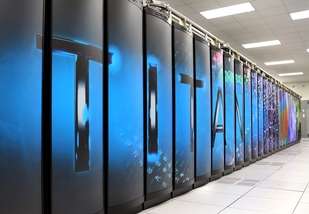Titan is also a green powerhouse

Not only is Oak Ridge National Laboratory's Titan the world's most powerful supercomputer, it is also one of the most energy-efficient.
Titan came in at number three on the Green500 list. Organized by Virginia Tech's Wu-chun Feng and Kirk Cameron, the list takes the world's 500 most powerful supercomputers—as ranked by the Top500 list—and reorders them according to how many calculations they can get per watt of electricity.
The Green500 list was announced Wednesday during the SC12 supercomputing conference in Salt Lake City.
Titan's position reflects a significant power savings attributable to the system's hybrid architecture. Titan draws its computing strength from a combination of GPUs, whose pedigree goes back to gaming systems, and traditional CPUs. Because of their unique strength as number-crunchers, GPUs give Titan a tenfold boost in computing power, even though the system draws only modestly more power than a CPU-only system.
"With Titan, ORNL provides an exponential increase in scientific computing power toward predictive capabilities to address complex challenges without significantly increasing energy consumption," noted Jeff Nichols, ORNL associate laboratory director for computing and computational sciences.
The Cray XK7 system contains 18,688 nodes, each with a 16-core AMD Opteron 6274 processor and an NVIDIA Tesla K20X graphics processing unit (GPU) accelerator. Titan also has more than 700 terabytes of memory.
Because they handle hundreds of calculations simultaneously, GPUs can go through many more than CPUs in a given time. By relying on its 299,008 CPU cores to guide simulations and allowing its new NVIDIA GPUs to do the heavy lifting, Titan will enable researchers to run scientific calculations with greater speed and accuracy.
Provided by Oak Ridge National Laboratory




















